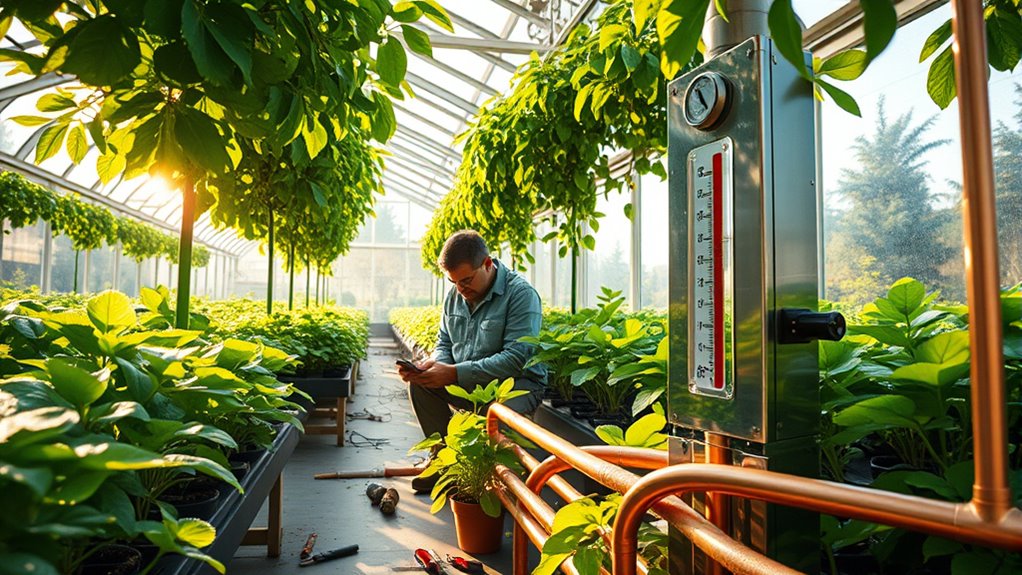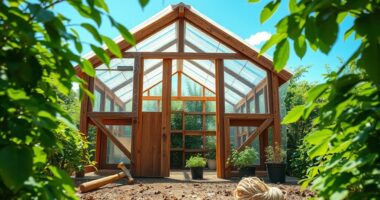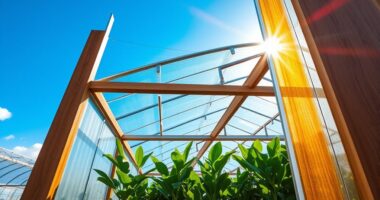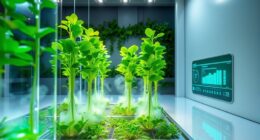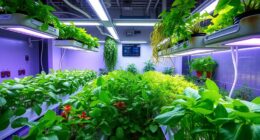Setting up a heating system for your greenhouse starts with understanding your heating needs based on size and insulation. Consider central heating for efficiency and even temperature distribution. Choose the right unit heaters, like vented or power-vented, for your budget. Don’t forget about maintenance to keep your system running smoothly and efficiently. With the right setup, you’ll create a thriving environment for your plants. Learn more about specific components and installation tips to enhance your greenhouse heating system.
Key Takeaways
- Assess your greenhouse size, insulation, and crop temperature needs to determine appropriate heating requirements.
- Choose between central heating systems for larger operations or unit heaters for smaller spaces based on your budget and installation flexibility.
- Ensure proper installation of heaters, including embedding pipes in sand or concrete for optimal heat distribution and maintaining adequate ventilation.
- Regular maintenance, including inspections and cleaning, can enhance efficiency and prolong the lifespan of your heating system.
- Consider automated climate controls and energy-efficient technologies, like heat pumps, to improve performance and reduce energy costs.
Understanding Greenhouse Heating Needs

Heating your greenhouse is essential for ensuring ideal plant growth, especially during the colder months.
Heating your greenhouse is crucial for optimal plant growth, particularly in colder seasons.
You need to carefully assess your heating requirements based on several factors, including the size and shape of your greenhouse, the type of insulation, and the external temperatures you face.
Remember, heating costs can make up 65% to 85% of your annual energy expenses, so you’ll want to optimize your system.
Different crops also have unique temperature needs, which can influence your heating design.
Additionally, consider how wind speed and the U-value of materials affect heat retention.
Types of Greenhouse Heating Systems
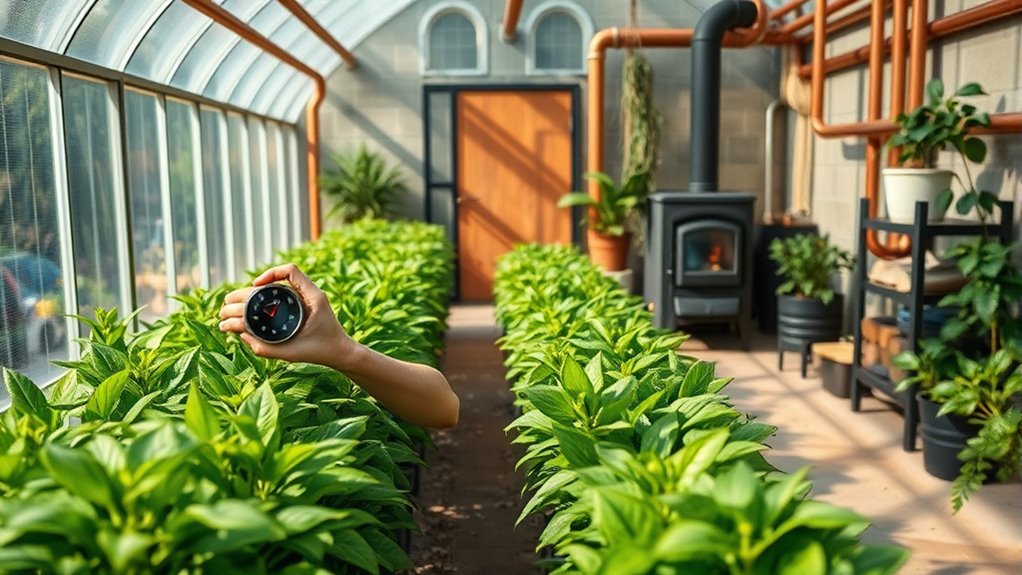
When choosing a heating system for your greenhouse, consider the benefits of central heating.
It can efficiently distribute warm air throughout the space, ensuring a consistent temperature for your plants.
Plus, understanding hot air efficiency can help you maximize your energy use and reduce costs.
Central Heating Benefits
While exploring options for your greenhouse, you’ll find that central heating systems offer numerous benefits over other heating methods.
These systems generate heat in one location and distribute it efficiently, allowing for a more controlled environment. Here are some key advantages:
- Space Efficiency: They save greenhouse space by centralizing the heating components outside.
- Flexibility: Maintenance and temperature control are easier, making adjustments simple.
- Energy Efficiency: Particularly beneficial for larger operations, they help reduce energy costs.
- Reduced Toxic Gases: Combustion occurs outside, minimizing harmful gas exposure to plants and people.
With these benefits, central heating systems are a smart choice for ensuring your greenhouse thrives all year round.
Hot Air Efficiency
Choosing the right heating system for your greenhouse can markedly impact its efficiency and plant health.
Hot air systems, including vented and unvented heaters, are popular options. Vented heaters boast thermal efficiencies around 80%, while high-efficiency condensing models can exceed 90%.
Forced hot air systems heat quickly and control humidity but are less efficient due to air’s poor heat conduction. In contrast, radiant heat systems excel in uniform heating and can reduce long-term costs.
Under-bench heating is effective for root zones and can allow lower thermostat settings. Regular maintenance boosts efficiency by up to 10%, ensuring peak performance and reduced fuel consumption.
Prioritize a well-maintained system for maximum greenhouse health and efficiency.
Components of Central Heating Systems
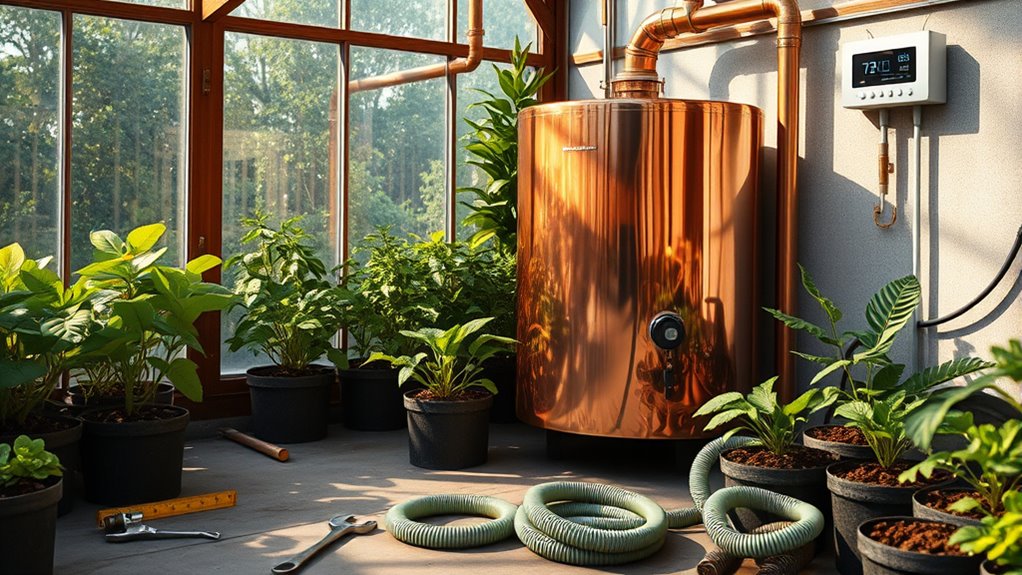
When setting up your greenhouse heating system, understanding the components is key.
You’ll want to familiarize yourself with different boiler types and their functionality, as well as the materials used for distribution pipes.
Each element plays an essential role in ensuring efficient heat transfer throughout your greenhouse.
Boiler Functionality and Types
Boilers play an essential role in greenhouse heating systems, as they heat water or produce steam to maintain ideal temperatures for plant growth.
Understanding the types of boilers and their functionalities can help you choose the right one for your greenhouse.
- Fire-Tube Boilers: Simple and cost-effective, perfect for constant load situations.
- Water-Tube Boilers: Flexible and ideal for varying heating demands.
- Condensing Boilers: Highly efficient, utilizing exhaust heat to save energy.
- Closed Combustion Boilers: Better efficiency and lower emissions compared to older models.
Distribution Pipe Materials
After selecting the right boiler for your greenhouse, the next step is to focus on the distribution pipe materials that will carry the heated water or steam throughout the space.
Common options include steel, copper, and aluminum. While copper is durable, it’s pricier, whereas aluminum is lighter and less expensive.
For ideal heat transfer, consider using finned pipes, as they transfer heat more efficiently than smooth ones.
When installing, think about pipe placement; along the walls or under benches can help guarantee uniform temperature. Insulating the pipes also reduces heat loss during transport.
Choosing the Right Unit Heaters

Choosing the right unit heaters for your greenhouse is crucial to creating an ideal growing environment.
You’ll want to take into account several factors to guarantee maximum efficiency and comfort for your plants.
- Vented vs. Unvented: Vented heaters exhaust gases outside, making them safer.
- Fuel Options: Decide between natural gas, propane, and kerosene based on availability.
- Installation Flexibility: Power-vented heaters allow for easier installation with horizontal exhaust pipes.
- Heat Distribution: Use convection or forced air systems to evenly distribute heat throughout the space.
Efficiency and Cost Considerations
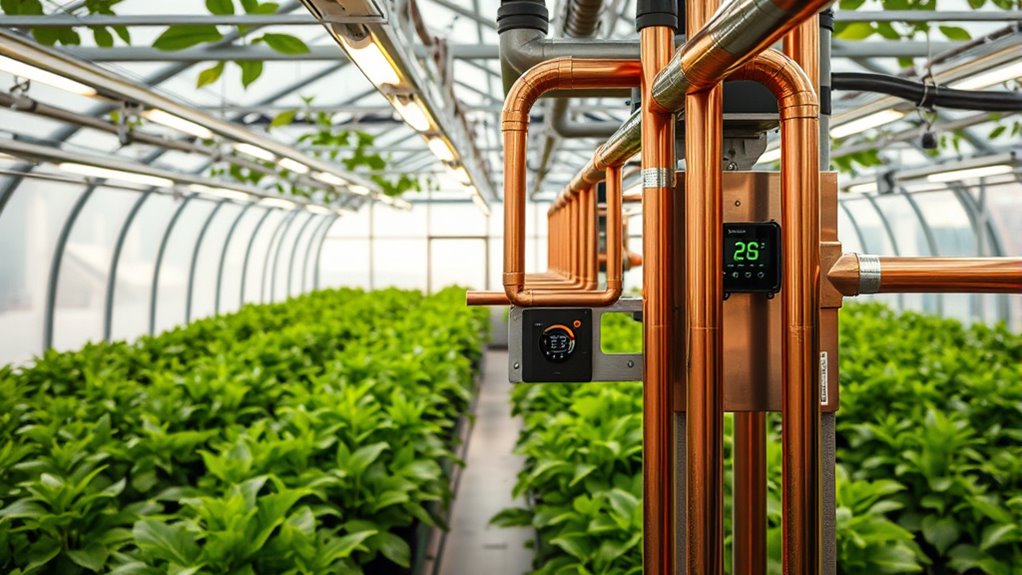
Selecting the right unit heaters is just the beginning; efficiency and cost considerations play a significant role in maximizing your greenhouse’s performance.
Regular maintenance can boost your heating system’s efficiency by 5-10%, which often offsets servicing costs. Conduct efficiency tests to spot issues early, and guarantee adequate make-up air for ideal combustion.
Maintaining at least 110 volts prevents motor overheating, guaranteeing smooth operation. A mere 2% increase in efficiency can save around 200 gallons of fuel oil during winter.
Consider energy audits to identify tailored energy-saving opportunities, and explore rebates from utility companies for installing energy-efficient technologies.
Finally, switching to efficient fuels like natural gas can lead to substantial cost savings, enhancing your greenhouse’s overall financial health.
Heating Distribution Methods

When it comes to heating your greenhouse effectively, understanding the various heating distribution methods is essential for optimizing temperature control.
Each method has its unique benefits, so consider your specific needs when choosing one.
- Hot Air Systems: Quickly warm the air using furnaces or heaters.
- Poly Tube Systems: Distribute heat through perforated tubes, often needing a blower.
- Root Zone Heating: Focuses on warming the soil directly, using hot water pipes or mats.
- Infrared Systems: Transfer heat directly to your crops without much air movement.
Environmental and Safety Considerations

Although heating your greenhouse is fundamental for plant growth, it’s equally important to reflect on the environmental and safety implications of your heating system.
Reducing energy consumption not only cuts costs but also minimizes your environmental impact. Consider renewable energy options like solar or geothermal systems for a greener approach. Remember, traditional heating methods can contribute to greenhouse gas emissions, so choosing energy-efficient systems is essential for lowering your carbon footprint. Additionally, utilizing Ground Source Heat Pumps can significantly enhance energy efficiency while providing sustainable heating solutions for your greenhouse. Geothermal energy systems have a small carbon footprint and can be a reliable source of heat for your greenhouse. Furthermore, energy-efficient technologies in heat pumps can further reduce operational costs and environmental impact. Regular maintenance can enhance the efficiency of the refrigeration cycle by up to 70%, making it a vital aspect of your heating strategy. Furthermore, understanding the Coefficient of Performance (COP) of your system can help you assess its efficiency and make informed decisions for improvements.
Reduce energy consumption and consider renewable heating options to minimize costs and environmental impact while lowering your carbon footprint.
On the safety side, guarantee proper ventilation to prevent overheating and humidity buildup. If you use combustion units, make sure they’re vented outside to avoid harmful gases.
Regular maintenance of your equipment is imperative for safe and efficient operation, helping you maintain a healthy environment for your plants.
Installation Tips for Your Heating System

To guarantee your greenhouse heating system operates efficiently, it’s vital to follow a few key installation tips.
Start by choosing the right heat source that fits your greenhouse size and budget. Make certain to embed pipes properly in sand or concrete for ideal heat distribution.
When installing components, position circulating pumps near expansion tanks to minimize pressure issues. Don’t forget about proper ventilation; it helps distribute heat evenly and prevents moisture buildup.
- Use thermal mass materials to stabilize temperatures.
- Ascertain all electrical setups are safe and dedicated.
- Install thermostat controls for precise temperature management.
- Keep air eliminators in place to maintain system efficiency.
These steps will help you create a reliable heating system for your greenhouse.
Maintenance Practices for Optimal Performance
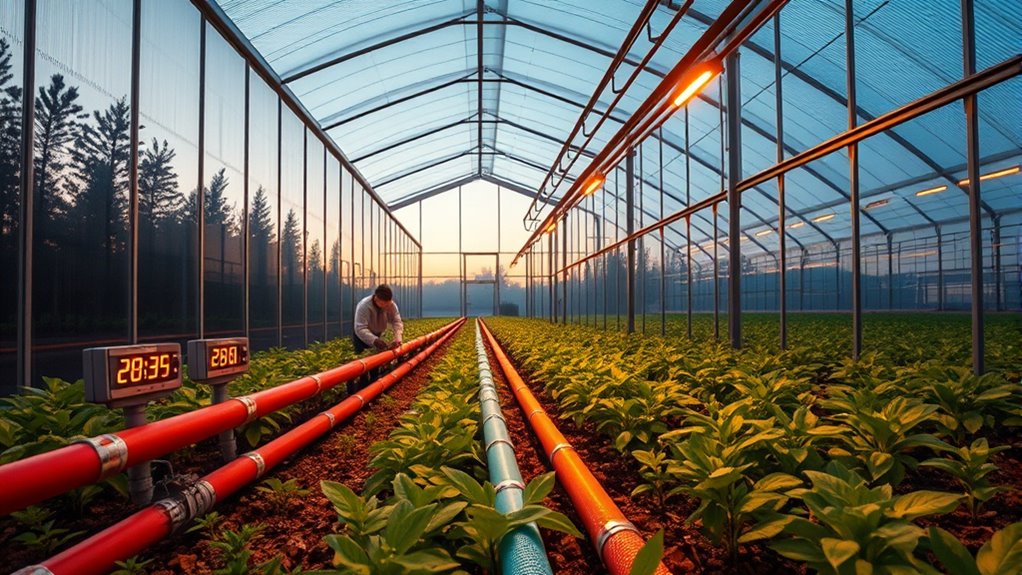
Once your heating system is installed, regular maintenance becomes key to guaranteeing it runs efficiently. Start with seasonal visual inspections to identify wear or corrosion.
Clean your heater and ductwork to prevent dust buildup, and check that vents are unobstructed for maximum airflow. Don’t forget to calibrate your thermostat for accurate temperature control. Regular maintenance can also prolong the lifespan of your heating system, ensuring it operates effectively for years to come. Additionally, consider heat pump technology for enhanced energy efficiency and performance in your greenhouse. Geothermal heat pumps achieve efficiency ratings of 300% to 600%, making them an excellent choice for sustainable heating.
Maintain efficiency by cleaning your heater and ductwork, ensuring unobstructed vents, and calibrating your thermostat for precise temperature control.
To maximize efficiency, ensure that your heat pump is installed correctly, as poor installation practices can lead to operational issues.
On a preventative note, regularly clean fans and inspect for leaks. Lubricate moving parts to guarantee smooth operation, and conduct combustion tests for safety.
Always shut down your system properly during off-seasons and inspect for gas leaks regularly. Finally, plan for future replacements and consider upgrades to high-efficiency systems.
Investing in automated climate controls can also enhance performance and ease management, as heat pumps filter and circulate indoor air, improving air quality in your greenhouse.
Frequently Asked Questions
What Are the Best Heating Systems for Small Greenhouses?
When you’re looking for the best heating systems for small greenhouses, consider electric heaters for easy installation and precise temperature control.
They’re clean and efficient, making them ideal for smaller spaces.
Alternatively, gas heaters offer high heat output and lower operating costs, perfect for larger setups.
If you’re eco-conscious, solar and geothermal systems provide sustainable options, though they require more complex setups.
Always prioritize insulation and safety features to maintain a healthy environment.
How Do I Calculate Heating Requirements for My Greenhouse?
To calculate heating requirements for your greenhouse, start by determining its total surface area, including walls and roof.
Next, find the U-value for your materials to assess heat loss.
Calculate the temperature difference between inside and outside, and factor in infiltration losses from air leaks.
Finally, apply a wind correction factor to address increased heat loss.
This process helps you estimate how much heat you’ll need to maintain ideal conditions.
Can I Use Renewable Energy for Greenhouse Heating?
Yes, you can definitely use renewable energy for greenhouse heating! Options like solar panels, biomass, and geothermal systems offer sustainable solutions.
Solar energy provides electricity to power heaters, while biomass uses local materials for efficient heating. Geothermal systems tap into underground heat.
What Are the Signs My Heating System Needs Maintenance?
If you notice unusually high heating bills, that’s a red flag your system might be failing.
Noisy operation or inconsistent temperatures also signal maintenance needs. Frequent repairs and the age of your unit—especially if it’s over 15 years—are further indicators.
Regular visual inspections, cleaning, and checking airflow can help you maintain efficiency.
Don’t forget to calibrate the thermostat and guarantee everything’s in good shape before the heating season starts!
How Do Different Plants Affect Greenhouse Heating Needs?
Different plants require different temperatures, so you’ll need to adjust your heating accordingly.
Cool-loving plants like azaleas thrive at around 50°F, while roses and tomatoes prefer about 65°F.
Tropical plants, on the other hand, enjoy the warmth of around 70°F.
Conclusion
As you commence on setting up your greenhouse heating system, remember that the right choices can mean the difference between thriving plants and a failed crop. You’ve explored various heating types and methods, but the real challenge lies ahead—ensuring ideal performance and efficiency. Will your system stand up to the cold? With careful installation and maintenance, you can create a warm sanctuary for your plants. The success of your greenhouse depends on the decisions you make today.
